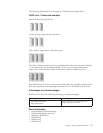
Advantages and disadvantages
RAID level-0 offers the following advantages and disadvantages.
Advantages Disadvantages
v Substantial speed enhancement
v Maximum utilization of physical drive
storage capacity, because no room is taken
for redundant data or data-parity storage
No data redundancy, resulting in data loss
in the event that a physical drive fails
More information
v Understanding RAID technology
v Understanding stripe-unit size
v Selecting a RAID level
v RAID level-1
v RAID level-1 Enhanced
v RAID level-5
v RAID level-5 Enhanced
v RAID level-5EE
v RAID level-6
v RAID level-x0
v RAID volumes
v Software and hardware support of RAID levels
Understanding RAID level-1
RAID level-1 uses data mirroring. Two physical drives are combined into an array,
and data is striped across the array. The first half of a stripe is the original data;
the second half of a stripe is a mirror (that is, a copy) of the data, but it is written
to the other drive in the RAID level-1 array.
RAID level-1 provides data redundancy and high levels of performance, but the
storage capacity is diminished. Because the data is mirrored, the capacity of the
logical drive when assigned RAID level-1 is 50% of the array capacity.
RAID level-1 requires two physical drives.
The following illustration shows an example of a RAID level-1 logical drive.
RAID level-1 example
Start with two physical drives.
Create an array using the two physical drives.
Chapter 3. Using ServeRAID Manager 35


















